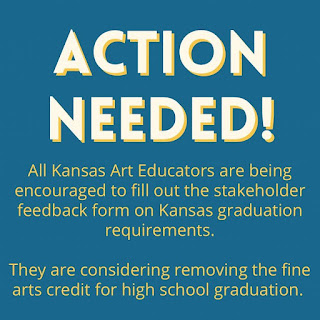Action Needed: Kansas Graduation Requirements Task Force
The Kansas State Board of Education has assembled a Graduation Requirement Task Force that is reviewing graduation requirements for Kansas students. One item being considered is the reduction or ELIMINATION of the Fine Arts credit graduation requirement.
The Task Force is currently seeking stakeholder feedback.
Here is the letter we sent:
March 7, 2022
To the Kansas State Board of Education: Janet Waugh, Melanie Haas, Michelle Dombrosky, Ann E. Mah, Jean Clifford, Deena Horst, Ben Jones, Betty Arnold, Jim Porter, Jim McNiece and the Graduation Requirements Task Force
We are writing on behalf of the Kansas Art Education Association, the largest association of art educators across the state of Kansas. Our executive board, a group of passionate teachers across regions and grade levels throughout Kansas, respectfully requests that the Kansas State Board of Education allow our association to be a part of the conversation on eliminating the Fine Arts Credit as a graduation requirement for Kansas students, one of the possibilities being considered by the Graduation Requirements Taskforce.
The visual arts are an essential part of a well-rounded education, basic to the education of all students. Visual arts education provides every student opportunities to develop the essential 21st century learning skills of communication, collaboration, creativity, critical thinking and problem solving. The fine arts are designed to build qualities such as individuality, cultural awareness, social awareness, the ability to work with others, the ability to identify and solve unique problems, and to help students grow emotionally and intellectually in ways other courses are not. The arts assist in one’s development in innovative ways that can provide successes that go beyond the present.
The vision of the Kansas State Board of Education states, “Kansas leads the world in the success of each student.” We believe the arts are integral to student success. In addition to supporting students’ social emotional learning, the arts help develop thinking skills, dubbed the Studio Habits of Mind as part of Harvard Graduate School of Education’s Studio Thinking Project, which are important for any future career students may choose to pursue.
Given the research on employment trends and, anticipating that a variety of new career opportunities will emerge over time, that visual arts education is essential to every learner’s educational foundation and training for future employment in an increasingly complex and interconnected world. When surveyed, CEOs identified creativity as the number one trait sought when hiring. Since learners are future contributors and creative leaders of tomorrow’s workforce, this underscores the importance that every learner must have ongoing access to sequential visual arts education throughout their PreK-12 education.
One of the case studies mentioned in the task force’s presentation mentioned a student who wants to be a doctor and feels as though her fine arts credit is holding her back from taking courses that are more pertinent to her future career. In reality, Ivy League medical schools acknowledge the benefits of arts courses for future doctors. The Yale School of Medicine requires students to spend time in art museums developing their observational skills which helps them become better at diagnosis and improves their bedside manner. A Columbia University study indicated that medical students and professionals demonstrated an increased capacity for personal reflection, awareness of personal bias, and tolerance of ambiguity- all skills that can have a tangible effect on patients’ diagnoses- after taking part in a six-week art course. Roger Kneebone, professor of surgical education at Imperial College, London, said that incoming medical students lack the manual dexterity to perform sutures and calls for an increase in hands-on creative courses. These are just a few examples of engaging with the arts having lasting positive effects on students’ futures even if their future career is outside of the art field.
We urge the Task Force to reconsider the recommendation to eliminate or reduce the fine arts credit requirement for high school graduation and the Board of Education to reaffirm the importance of fine arts education for all Kansas students. We have included more information on the following page with research and proof as to the importance of fine arts in a well rounded education. Reducing or eliminating the fine art's credit would be a disservice to Kansas students and would have lasting and detrimental effects on our entire state. We would love to speak with you more about this important issue and look forward to engaging in conversation on the education of Kansas students.
Thank you for your consideration,
The Kansas Art Education Association
Elizabeth Madden, President, president@kaea.com
Kathy Schroeder, President-Elect, presidentelect@kaea.com
Katie Morris, Board Member, webmaster@kaea.com
Alyssa Passmore, Board Member, advocacy@kaea.com
Links for Further Information Supporting Required Fine Arts Courses
Coughlan, S. (2018, October 30). Surgery students 'losing dexterity to Stitch Patients'. BBC News. Retrieved February 28, 2022, from https://www.bbc.com/news/education-46019429#:~:text=A%20professor%20of%20surgery%20says,stitching%20or%20sewing%20up%20patients
Fulton, Mary https://ednote.ecs.org/author/mary-fulton/. (2021, November 19). The Importance of Arts Education in workforce preparation. Ed Note. Retrieved February 28, 2022, from https://ednote.ecs.org/the-importance-of-arts-education-in-workforce-preparation/
Newman, C. (2020, January 23). How time spent in an art museum can improve medical students' skills. UVA Today. Retrieved February 28, 2022, from https://news.virginia.edu/content/how-time-spent-art-museum-can-improve-medical-students-skills
The Studio Thinking Project. The Studio Thinking Project | Project Zero. (n.d.). Retrieved February 28, 2022, from http://www.pz.harvard.edu/projects/the-studio-thinking-project
Yale School of Medicine. (2014, May 27). How looking at paintings became a required course in medical school. Yale School of Medicine. Retrieved February 28, 2022, from https://medicine.yale.edu/news/yale-medicine-magazine/article/how-looking-at-paintings-became-a-required-course/


Comments
Post a Comment